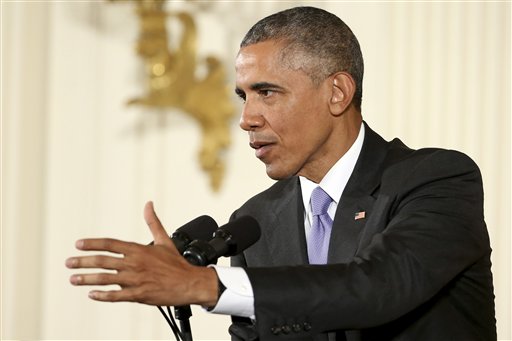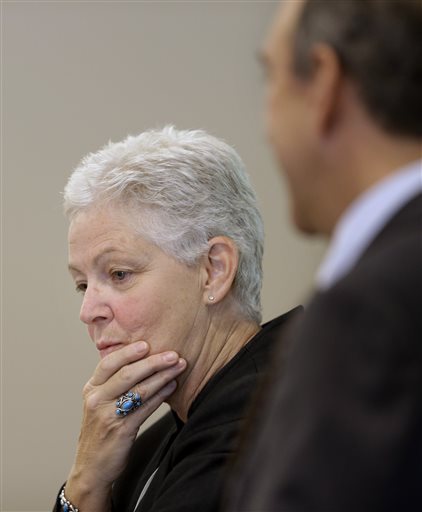Coming soon: Final EPA ‘Clean Power Plan
July 29, 2015 by Ken Ward Jr.
The New York Times reports today:
The final version of President Obama’s signature climate change policy is expected to extend an earlier timeline for states to significantly cut planet-warming pollution from power plants, according to people familiar with the plan.
If enacted, the climate change plan, the final version of which is expected to be unveiled as early as Monday, could stand as the most significant action ever taken by an American president to curb global warming. But some environmental groups have cautioned that a later deadline for states to comply could make it tougher for the United States to meet Mr. Obama’s climate change pledges on the world stage.
This is just the latest in a series of press reports that try to predict when the U.S. Environmental Protection Agency is going to issue the final version of its Clean Power Plan and what that EPA plan will say.
One story from U.S. News and World Report, for example, said:
A sweeping federal rule that would curtail carbon emissions from power plants will likely be made even more stringent when it is finalized later this summer, according to the Natural Resources Defense Council, widely regarded as a close ally of the Environmental Protection Agency.
The rule, known as the Clean Power Plan, was unveiled by the EPA in June 2014. The subject of more than 4.3 million public comments, it is the keystone of President Barack Obama’s climate agenda and vigorously opposed by conservatives and industry groups.
“We are very optimistic and confident that it will be stronger, in particular in the areas of renewables and efficiencies,” NRDC President Rhea Suh said during a press briefing Wednesday at the organization’s headquarters in the nation’s capital.
UPDATED: Here’s a new report out today from EnergyWire:
U.S. EPA appears to be leaning toward giving states an extra two years — until 2022 — to start cutting carbon emissions from power plants under a final Clean Power Plan rule expected to be rolled out as early as Monday.
The rule will also provide more time for states to submit final plans, according to a timeline E&E obtained that was posted to EPA’s website.
Moving out the compliance dates could strengthen support from states friendly to the Obama administration’s climate plan and assuage the concerns of some critics. Across the political spectrum, state officials and energy companies have said more time is a concession EPA could grant in a final rule that would make it easier to cut greenhouse gas emissions 30 percent below 2005 levels by 2030 (ClimateWire, July 27).
Another piece from ClimateWire reported:
In countless meetings on the Clean Power Plan with states and energy companies, the most common plea to U.S. EPA has been for more time. More time to work on plans, more time to allow coal plants to retire and more time to move toward final goals.
It’s an easy concession for EPA — one that could go a long way toward ensuring flexibility under the rule without undercutting climate goals, knowledgeable observers say.
In particular, EPA has heard it should relax the rule’s interim goals, which require states to reach an average emissions rate between 2020 and 2029.
It’s a “big problem, and an unnecessary problem, with respect to the real goals of this regulation,” said Ken Colburn, a principal at the Regulatory Assistance Project, which advises state regulators tasked with writing carbon-cutting plans to meet state-specific targets.

All we really know for sure, though, is that EPA’s current regulatory agenda says that the final rule is due out in August, and that it’s still listed as being under review at the White House Office of Management and Budget.
Here in West Virginia, of course, we can expect more of the same when EPA does issue the final rule. Coal industry officials and just about every politician in the state will be falling all over themselves to get out their statements, all trying to outdo each other with their rhetoric. Some of that is already happening … Here’s the video, for example, of Rep. David McKinley’s recent House floor presentation:
Then there was Murray Energy President Bob Murray’s speech last week to an Ohio County Republican dinner, as reported here by SNL’s Taylor Kuykendall:
What is behind this destruction of our jobs and livelihood? It is a political power grab of America’s power grid. It is being done to radically transform American society. How better to do it than to get control of the availability, reliability and cost of electricity, a staple of life.
(Interestingly, that story also contained this discussion of West Virginia’s 2016 gubernatorial election: Murray urged support of West Virginia Attorney General Patrick Morrisey, who has been actively involved in suing the Obama administration. He also called for support of Senate President Bill Cole in his bid for governor. Cole is running against Jim Justice, recently identified by Forbes as the richest person in West Virginia, and other candidates, including Kessler. Despite Justice’s earning much of his fortune from coal assets, Murray said that when he received a call asking him to support Justice, he said he would actually oppose him. “This somewhat startled the politician asking for my support, but I explained that Mr. Justice does not contribute to or participate in any of the four major coal associations in America and West Virginia, and that I was aware of about 20 lawsuits against him for not paying his bills, a bad image for the coal industry,” Murray said.)
Then there was a fairly ridiculous commentary in the State Journal by West Virginia Public Service Commissioner Brooks McCabe headlined “Is the sky falling for the coal industry or not?”:
 Many people think the sky is falling and the end of coal is near. For avid readers of the press, negativity is everywhere you look … There is no doubt the coal industry is in a crisis and some companies will not survive. This is a real-time example of creative destruction hitting the coal industry and West Virginia in the gut. The world is changing in dramatic ways and coal must reset its baselines and develop new strategies for the future. But the sky is not falling and the end of coal is nowhere near in sight.
Many people think the sky is falling and the end of coal is near. For avid readers of the press, negativity is everywhere you look … There is no doubt the coal industry is in a crisis and some companies will not survive. This is a real-time example of creative destruction hitting the coal industry and West Virginia in the gut. The world is changing in dramatic ways and coal must reset its baselines and develop new strategies for the future. But the sky is not falling and the end of coal is nowhere near in sight.
This kind of trauma being subjected upon the industry is creating a major reordering of the industry. Although it has started with divestitures and some bankruptcies, it is not over yet. The next 18 months will be a rough ride. But the industry will survive, just as it did in the late 1920s, and the early years of The Great Depression. The sky is not falling; the end of coal is not near; albeit the future will be very different than the past.
While Commissioner McCabe is correct that current government projections show coal isn’t going to disappear, it’s important to look more closely at this part of his “analysis” of future production projections:
The West Virginia University Bureau of Business & Economic Research recently issued a report, “Coal Production in West Virginia: 2015-2035.” The short-term impacts have been well presented on many fronts, but less discussed and less understood is that coal will play a major role for years to come. The report forecasts that coal production will contract from 104 million tons in 2015 to 98 million tons in 2016. This is from 158 million tons in 2008. A key point is that most of the contraction has already occurred. Although the coal industry may not be at the bottom of its current economic cycle, it is nearing the bottom. The report forecasts a modest rebound up to 105 million tons between 2017 and 2020. This is not the end of coal; it is just in the middle of a major reset.
This ignores a key part of the picture about the differing outlook for the coalfields in Northern and Southern West Virginia, which we’ve explained before, based on that same WVU report:
In the short term, WVU’s report projects that West Virginia coal production will decline to about 104 million tons this year before contracting further, to 98 million tons, in 2016. Over a longer term, WVU projected a slight rise in production between 2017 and 2020, to nearly 105 million tons.
“Retirements of coal-fired generation will taper off and, while no measurable amount of capacity additions to the coal-fired fleet are likely, an expected increase in natural gas prices should allow coal to regain some share of electricity generation,” the report said.
But, for the remainder of the period examined — through 2035 — statewide coal production is expected to drop, reaching less than 96 million tons by the end of that period, the WVU report said.
“This will be driven entirely by losses in production in the state’s southern coalfields,” the report said. “Northern West Virginia production will likely experience a solid rebound through 2020 that will then remain relatively stable level over the remaining portion of the forecast.”

Of course, Commissioner McCabe also ignores the troubling fact that the ongoing decline of the state’s coal industry — especially in Southern West Virginia — has long been predicted, with little planning for it by state officials, and is unlikely to be stopped by continuing to fight action on climate change.
In the end, Commissioner McCabe puts us in a box where West Virginia continues to focus a remarkable amount of time, energy, and political space on trying to reverse coal’s decline, and little of those precious resources on diversifying coalfield economies. If nothing else, though, the views expressed in Commissioner McCabe’s commentary may help to explain the PSC’s somewhat bizarre focus on micromanaging what Appalachian Power does with some of its oldest coal-fired power plants.
Meanwhile, when the Clean Power Plan comes out in its final form, remember that there are people and groups that are working hard to show that West Virginia can take action to meet the EPA goals and do our state’s part to help deal with the climate crisis (see here and here). And there are others among us who are working very hard on finding the answers to diversifying West Virginia’s economy (see here and here).
Blasting EPA is a pretty easy things for West Virginia political leaders to keep doing. Bringing people together to find real solutions to our state’s long-term problems is harder.

 Subscribe to the Coal Tattoo
Subscribe to the Coal Tattoo
